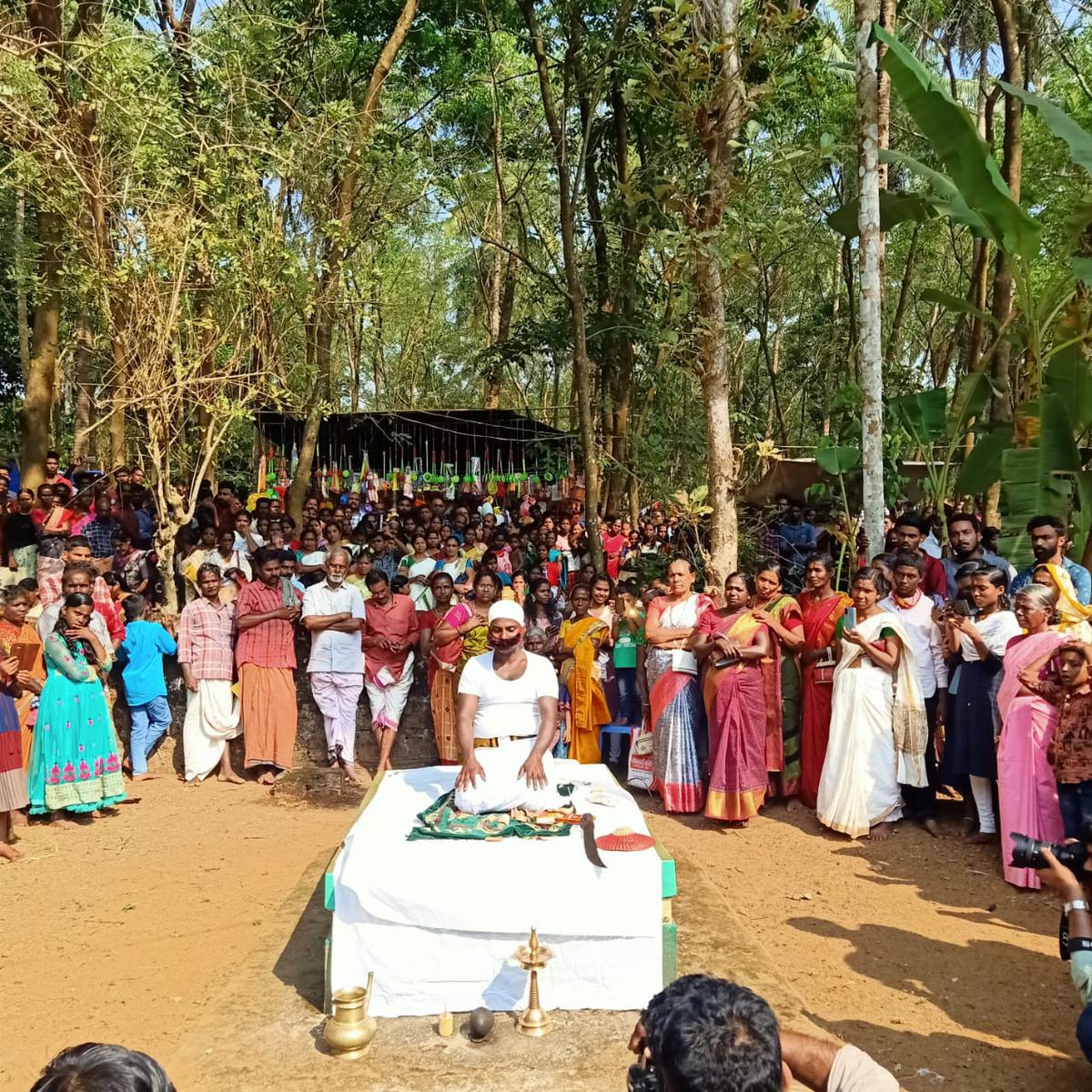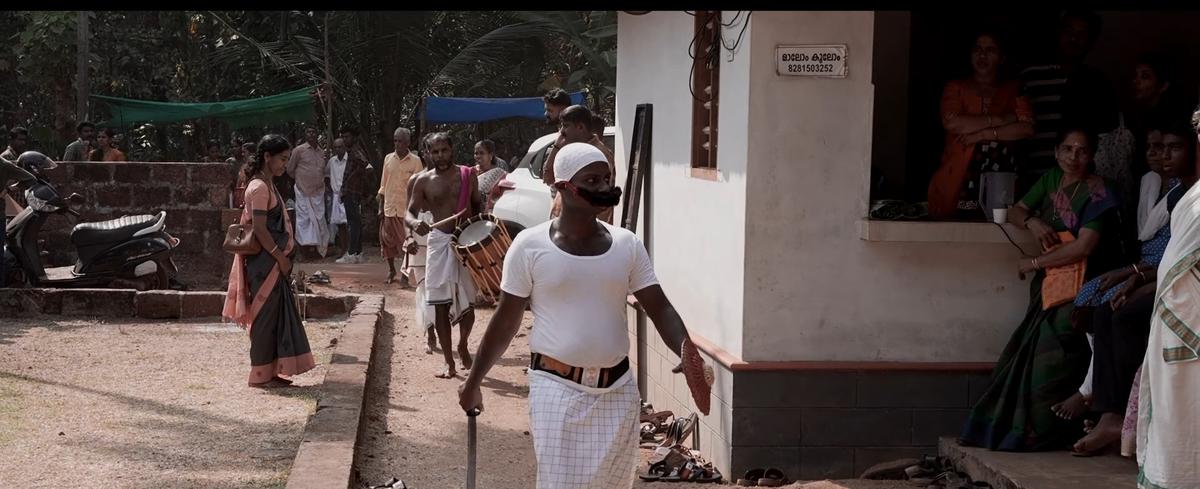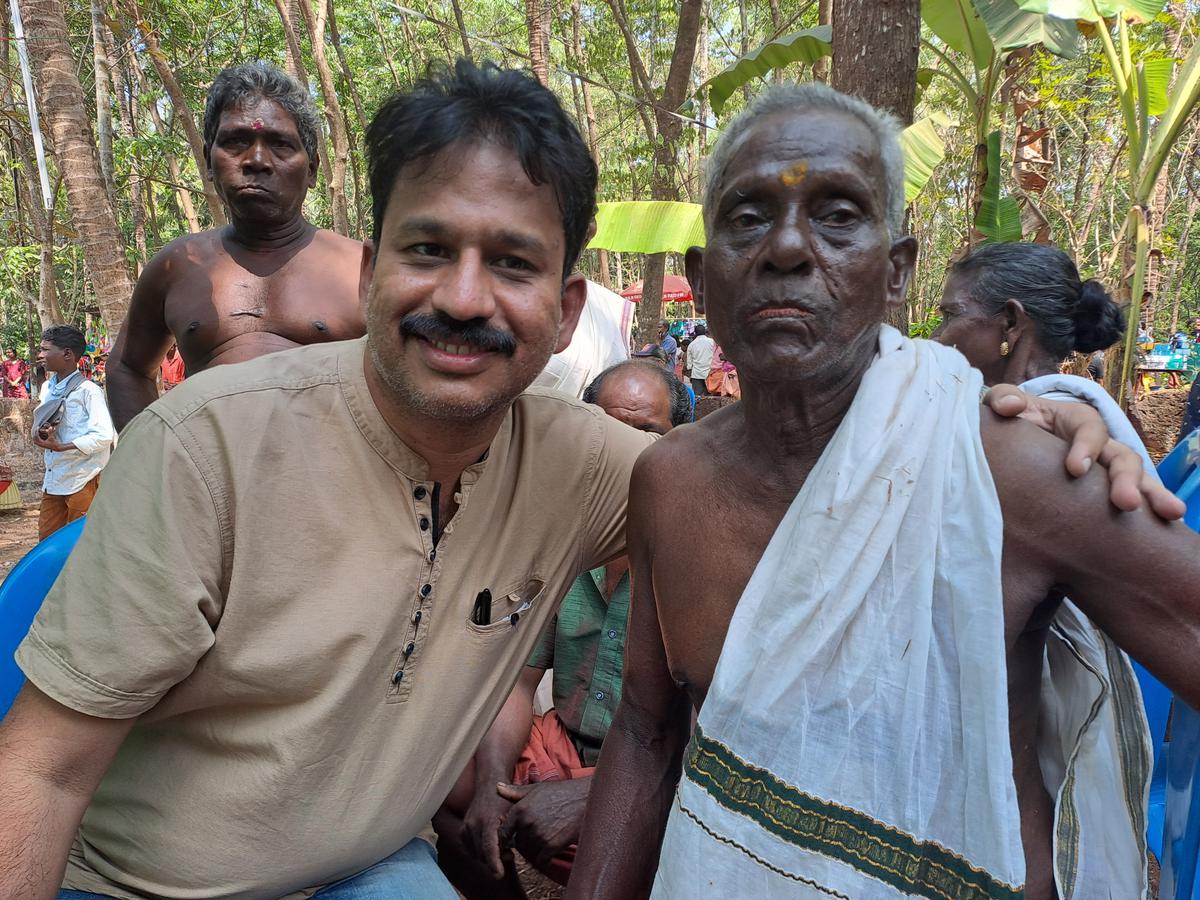Mukri Pokker Theyyam
| Photo Credit: Special Arrangement
Aneesh Maloth, dressed in a white vest with sleeves and white checkered lungi, walks towards the temple to the accompaniment of beats on a chenda. He wears a skull cap, sports a faux black moustache and carries a sword and shield. On the temple premises, he recites the azaan (Islamic call to prayer) and offers namaz (prayer). Devotees gathered at the temple watch as he performs and seek his blessings. This is not a work of fiction. It happens every year at Malom Koolom Bhagavathy Temple near Vellarikkundu in Kasaragod district.
Aneesh is Mukri Pokker, a Mappila Theyyam, a variant of Theyyam in which Muslim characters are revered as gods. Ashraf Thoonery has showcased this Theyyam in his documentary Mukri with Chamundi : The Saga of Harmony in Theyyam Art.

Mukri Pokker Theyyam offering namaz on the temple premises
| Photo Credit:
SPECIAL ARRANGEMENT
Mappila is the colloquial term for Muslims that is used in many parts of Kerala and mukri means muezzin, who recites the azaan.
“Theyyam becomes a symbol of religious harmony and unity in Mappila Theyyam. I came across a small article about Mukri Pokker Theyyam in a newspaper and that intrigued me. I decided to find out more about it and that research eventually led to this documentary. I found that it is staged even in places that do not have a predominantly Muslim population as in the case of Malom,” says Ashraf, a journalist now working in Qatar.
Theyyam, the age-old ritualistic art form of North Kerala, often called the enchanting dance of the deities, expresses the physical presence of a deity, a Hindu god or goddess or a character from folk tales or a venerated person. There are around 400 Theyyams in Kerala and Mukri Pokker is among the 15-odd Mappila Theyyams performed in temples of North Kerala, especially at those in Kannur and Kasaragod. An underlying aspect of Mappila Theyyams is that the characters are spirits of someone good or evil who is killed or punished by the god or goddess.

Mukri Pokker Theyyam
| Photo Credit:
The Hindu
Myth behind the art
The story of Mukri Pokker is that he came from Ullal in Karnataka to Kooloth tharavadu (ancestral house) to look after the affairs of the house. But he got romantically involved with a woman there thus inviting the wrath of the family members. One day he was found dead under mysterious circumstances. Although it was impossible to kill him because he was wearing a talisman, it is believed that he was killed when he took off the talisman to take a bath. When the tharavadu faced problems an astrologer was consulted and it was advised that Mukri Pokker also be treated as a Theyyam with other Theyyams staged at the tharavadu every year.
While Theyyam is more of a spectacle with the artists donning elaborate make-up (facial painting), captive head gear and other embellishments, Mukri Theyyam sports nothing of the sort. It is among the 11 Theyyams performed at Malom and usually is staged alongside Theyyams such as Mandalath Chamundi, Dandyanganath Bhagavathy, Vishnumurthy and Gulikan. The documentary shows how the artistes who perform as Mukri Pokker and Chamundi seek the blessings of their ancestors and mentors at a designated space called pathi near their house in the presence of Mooppan, the head of the community.

Ashraf Thoonery (left) with Kannan Mooppan
| Photo Credit:
SPECIAL ARRANGEMENT
“Aneesh who becomes Mukri Pokker learnt how to perform the ritual ablutions before the prayer and the prayer itself from a revered person from the Muslim community,” Ashraf says. While people from the Maavilan and Koppaalan communities perform Theyyam in Kasaragod, it is done by those in Vannan community in Kannur.
Among other Mappila Theyyams are Aali, Aandi, Bappiriyan, Kunjali, Mammu, and Mammadu that are male Theyyams, while Ummachi and Neythyaar are female Theyyams. “The legends associated with these Theyyams are different.”
In the case of Aali Theyyam performed at Kumbala Aarikkudy Bhagavathy Temple in Kasaragod, Aali was a black magician who was punished by the goddess for misbehaving with women. The folklore behind Kalanthan Mukri Theyyam staged at Kamballur, also in Kasaragod, is that he was killed by an evil force and the spirit became one with the diety, Karinchamundi.
The documentary also throws light on other instances of how Theyyam becomes a bridge between Hindu and Muslim communities.
At the annual Kaliyatta Mahotsavam at Sree Paadarkulangara Bhagavathi temple in Perumbatta, a village near Malom, the Theyyam enters the courtyard of nearby Perumbatta Juma Masjid to conclude the performance.
The 18-minute documentary is scripted by Abdulla Abdul Hameed and Mujeeb Kariyaden. Camera is by Manoj AK and Sonu Damodhar. Editor is Anees Swaghathamadu. “We have got invites for screening from various universities and colleges. It is being sent to various film festivals after which it will be streamed on social media,” Ashraf says.